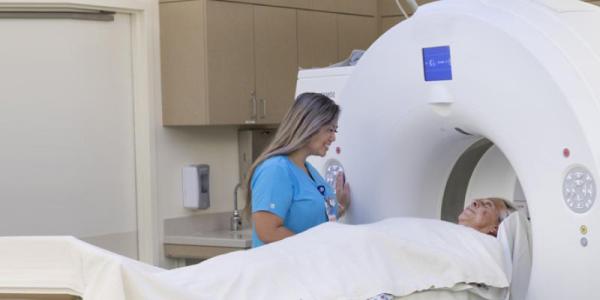
Diagnostic Radiologist Samuel Dawn, MD, shares his expertise on lung cancer screening. Dr. Dawn has been with El Camino Health for more than 10 years and has undergone specialty training in thoracic imaging and now practices as a diagnostic radiologist.
請點擊此轉換成中文
Skip
What is a low-dose CT scan?
A CT (computed tomography) scan is a medical imaging test which utilizes a series of X-rays to image a particular body part. The data obtained from the X-rays then undergo computer processing to create cross-sectional pictures ("slices"). A CT scan provides much better details of the anatomy compared to X-rays. A low-dose lung CT scan takes advantage of certain imaging characteristics of the lungs to minimize the radiation dose from the X-rays used. The low-dose lung CT scan is conducted to display any nodules in the lungs. If radiologists identify a nodule, which is a small growth in the lung, it can be evaluated for various characteristics, including size and density (width), to determine if the nodule is cancerous or benign.
In 2010, the National Lung Screening Trial released findings that participants who received low-dose CT scans had a 15 to 20% lower risk of dying from lung cancer than those who received standard chest X-rays. These findings were confirmed in 2018 by the major European NELSON trial, which released findings that annual low-dose CT scans in high-risk patients reduced lung cancer deaths up to 26% in men and up to 61% in women.
When is a low-dose CT scan appropriate for preventative care?
We recommend a low-dose CT scan if a person:
- Between 55 and 80 years of age
- Has smoked 30 pack-years (the equivalent of at least one pack of cigarettes a day for 30 years or two packs a day for 15 years)
- Is currently a smoker or have quit smoking within the past 15 years
- No signs of symptoms of lung cancer
This would place them in a high-risk category.
What are the risks of having a low-dose CT scan done?
The main concern with this procedure is reporting false positives. Approximately 95% of nodules displayed on a chest CT scan are benign. To combat overreporting, the American College of Radiology has increased the size of nodules classified as “positive.” This classification aims to decrease the number of false positives without increasing missed signs of cancer and helps to select only those patients with significant smoking history, and thus high-risk factors, for screening.
How often should you have a scan done if you are identified as being high risk?
We follow the Lung Reporting & Data Systems protocol. When a patient falls into the range of high risk, we encourage them to get a scan every year. If the scan doesn’t show anything significant, the patient should continue getting annual screenings until they no longer meet the high-risk criteria. If there is a significant abnormality, we may need to increase the frequency of screenings.
Are there any exclusions that prevent patients from getting low-dose CT scans?
In addition to having a significant smoking history and having quit within the past 15 years, if a patient displays any signs or symptoms of lung cancer, they do not qualify for a low-dose CT scan. In that case, they would need to undergo a diagnostic test.
What happens if you find something on the scan – what is the next step?
After evaluating whether or not the nodule is cancerous, a radiologist will refer the patient to a pulmonologist, oncologist, or other specialist at El Camino Health to determine the best course of action for treatment.
Does insurance cover low-dose CT screening scans?
Medicare and most insurance covers low-dose CT scans for people at high risk at our Los Gatos and Mountain View hospitals. But if your insurance doesn’t cover the test, El Camino Health offers a self-pay option (total cost of $175.48) that makes this test affordable.
Are You at Risk for Developing Lung Cancer?
Lung cancer is the third most common cancer in the US, behind skin cancer and breast cancer (in women) and prostate cancer (in men). Early detection is the key to effective treatment. Take this free assessment and in just a few minutes: identify your lung cancer risks, how to minimize your risk factors and what to do if you are at risk. Take the Assessment Now

